An official website of the United States government
 United States Department of Labor
United States Department of Labor
Provide barbering services, such as cutting, trimming, shampooing, and styling hair; trimming beards; or giving shaves.
Employment estimate and mean wage estimates for Barbers:
| Employment (1) | Employment RSE (3) |
Mean hourly wage |
Mean annual wage (2) |
Wage RSE (3) |
|---|---|---|---|---|
| 12,910 | 8.1 % | $ 17.16 | $ 35,700 | 3.2 % |
Percentile wage estimates for Barbers:
| Percentile | 10% | 25% | 50% (Median) |
75% | 90% |
|---|---|---|---|---|---|
| Hourly Wage | $ 10.79 | $ 12.65 | $ 14.41 | $ 21.51 | $ 25.60 |
| Annual Wage (2) | $ 22,430 | $ 26,300 | $ 29,970 | $ 44,730 | $ 53,260 |
Industries with the highest published employment and wages for Barbers are provided. For a list of all industries with employment in Barbers, see the Create Customized Tables function.
Industries with the highest levels of employment in Barbers:
| Industry | Employment (1) | Percent of industry employment | Hourly mean wage | Annual mean wage (2) |
|---|---|---|---|---|
| Personal Care Services | 12,290 | 1.89 | $ 17.15 | $ 35,670 |
| State Government, excluding schools and hospitals (OEWS Designation) | 70 | 0.00 | $ 23.98 | $ 49,880 |
| Civic and Social Organizations | 50 | 0.02 | $ 23.62 | $ 49,130 |
Industries with the highest concentration of employment in Barbers:
| Industry | Employment (1) | Percent of industry employment | Hourly mean wage | Annual mean wage (2) |
|---|---|---|---|---|
| Personal Care Services | 12,290 | 1.89 | $ 17.15 | $ 35,670 |
| Civic and Social Organizations | 50 | 0.02 | $ 23.62 | $ 49,130 |
| State Government, excluding schools and hospitals (OEWS Designation) | 70 | 0.00 | $ 23.98 | $ 49,880 |
Top paying industries for Barbers:
| Industry | Employment (1) | Percent of industry employment | Hourly mean wage | Annual mean wage (2) |
|---|---|---|---|---|
| State Government, excluding schools and hospitals (OEWS Designation) | 70 | (7) | $ 23.98 | $ 49,880 |
| Civic and Social Organizations | 50 | 0.02 | $ 23.62 | $ 49,130 |
| Personal Care Services | 12,290 | 1.89 | $ 17.15 | $ 35,670 |
States and areas with the highest published employment, location quotients, and wages for Barbers are provided. For a list of all areas with employment in Barbers, see the Create Customized Tables function.
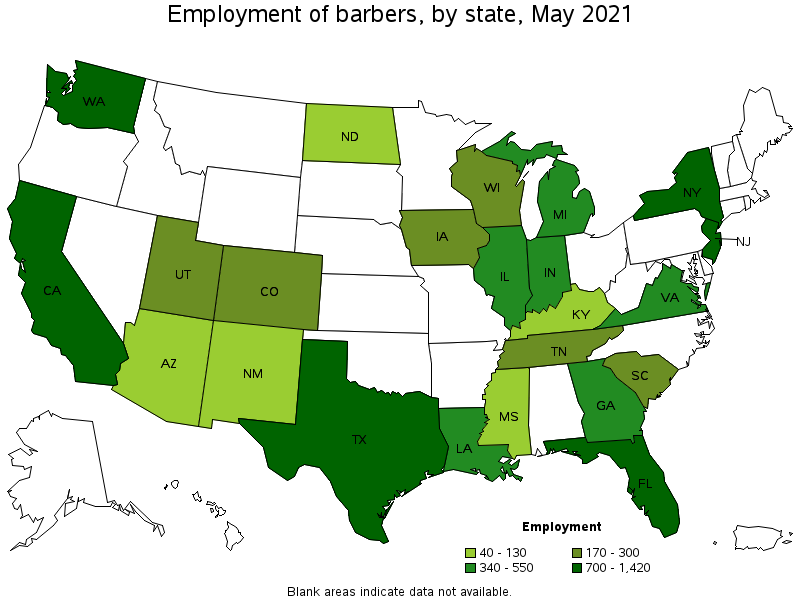
States with the highest employment level in Barbers:
| State | Employment (1) | Employment per thousand jobs | Location quotient (9) | Hourly mean wage | Annual mean wage (2) |
|---|---|---|---|---|---|
| New York | 1,420 | 0.16 | 1.78 | $ 17.27 | $ 35,920 |
| Florida | 1,400 | 0.16 | 1.78 | $ 15.03 | $ 31,270 |
| Texas | 1,270 | 0.10 | 1.13 | $ 13.72 | $ 28,550 |
| California | 860 | 0.05 | 0.57 | $ 21.08 | $ 43,840 |
| New Jersey | 730 | 0.19 | 2.06 | $ 19.84 | $ 41,270 |
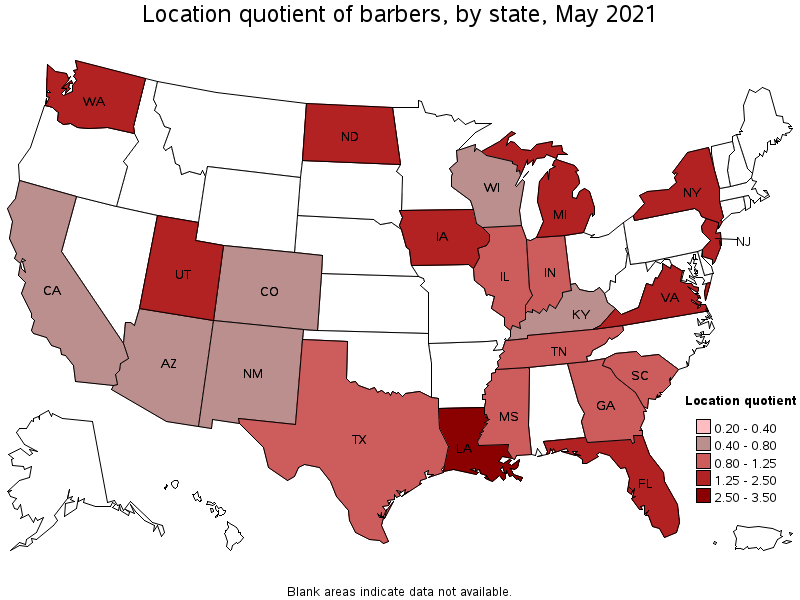
States with the highest concentration of jobs and location quotients in Barbers:
| State | Employment (1) | Employment per thousand jobs | Location quotient (9) | Hourly mean wage | Annual mean wage (2) |
|---|---|---|---|---|---|
| Louisiana | 460 | 0.26 | 2.79 | $ 17.46 | $ 36,320 |
| Washington | 700 | 0.22 | 2.39 | $ 25.60 | $ 53,250 |
| Utah | 300 | 0.19 | 2.12 | $ 11.43 | $ 23,780 |
| New Jersey | 730 | 0.19 | 2.06 | $ 19.84 | $ 41,270 |
| New York | 1,420 | 0.16 | 1.78 | $ 17.27 | $ 35,920 |
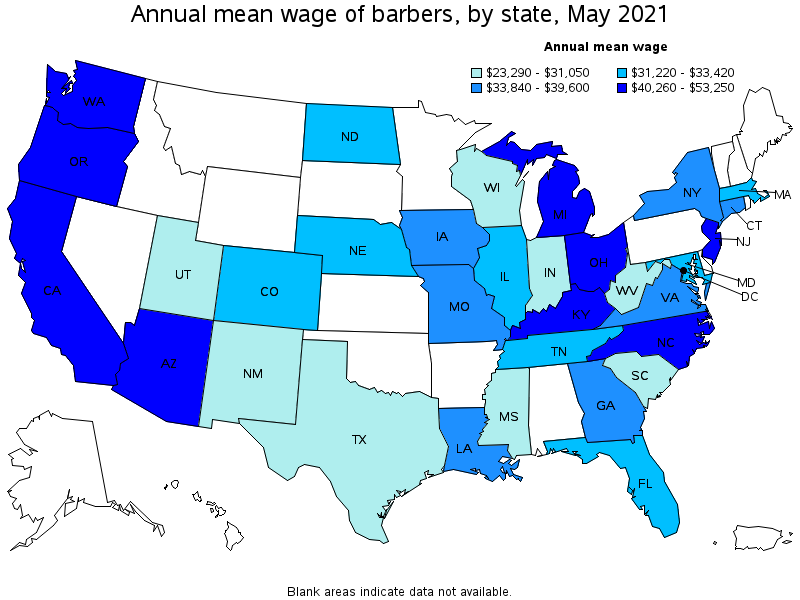
Top paying states for Barbers:
| State | Employment (1) | Employment per thousand jobs | Location quotient (9) | Hourly mean wage | Annual mean wage (2) |
|---|---|---|---|---|---|
| Washington | 700 | 0.22 | 2.39 | $ 25.60 | $ 53,250 |
| North Carolina | (8) | (8) | (8) | $ 23.98 | $ 49,870 |
| Arizona | 130 | 0.05 | 0.51 | $ 23.34 | $ 48,550 |
| Michigan | 490 | 0.12 | 1.32 | $ 23.05 | $ 47,950 |
| Oregon | (8) | (8) | (8) | $ 21.44 | $ 44,590 |
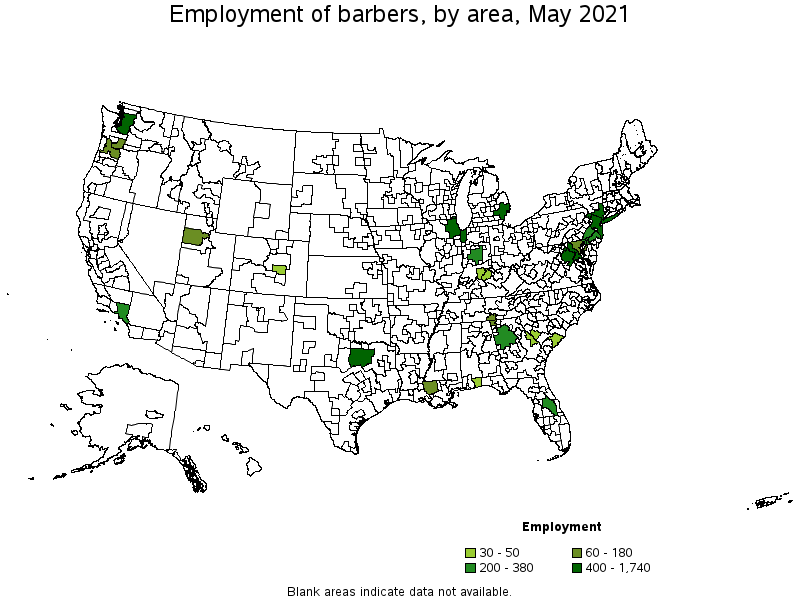
Metropolitan areas with the highest employment level in Barbers:
| Metropolitan area | Employment (1) | Employment per thousand jobs | Location quotient (9) | Hourly mean wage | Annual mean wage (2) |
|---|---|---|---|---|---|
| New York-Newark-Jersey City, NY-NJ-PA | 1,740 | 0.20 | 2.19 | $ 18.01 | $ 37,460 |
| Dallas-Fort Worth-Arlington, TX | 490 | 0.14 | 1.48 | $ 13.48 | $ 28,030 |
| Detroit-Warren-Dearborn, MI | 480 | 0.27 | 2.91 | $ 23.13 | $ 48,120 |
| Seattle-Tacoma-Bellevue, WA | 470 | 0.25 | 2.68 | $ 25.97 | $ 54,020 |
| Chicago-Naperville-Elgin, IL-IN-WI | 450 | 0.11 | 1.16 | $ 14.56 | $ 30,280 |
| Washington-Arlington-Alexandria, DC-VA-MD-WV | 400 | 0.14 | 1.49 | $ 16.44 | $ 34,180 |
| Los Angeles-Long Beach-Anaheim, CA | 380 | 0.07 | 0.73 | $ 20.96 | $ 43,590 |
| Atlanta-Sandy Springs-Roswell, GA | 290 | 0.11 | 1.22 | $ 16.95 | $ 35,260 |
| Philadelphia-Camden-Wilmington, PA-NJ-DE-MD | 270 | 0.10 | 1.11 | $ 15.96 | $ 33,200 |
| Orlando-Kissimmee-Sanford, FL | 240 | 0.20 | 2.24 | $ 16.52 | $ 34,350 |
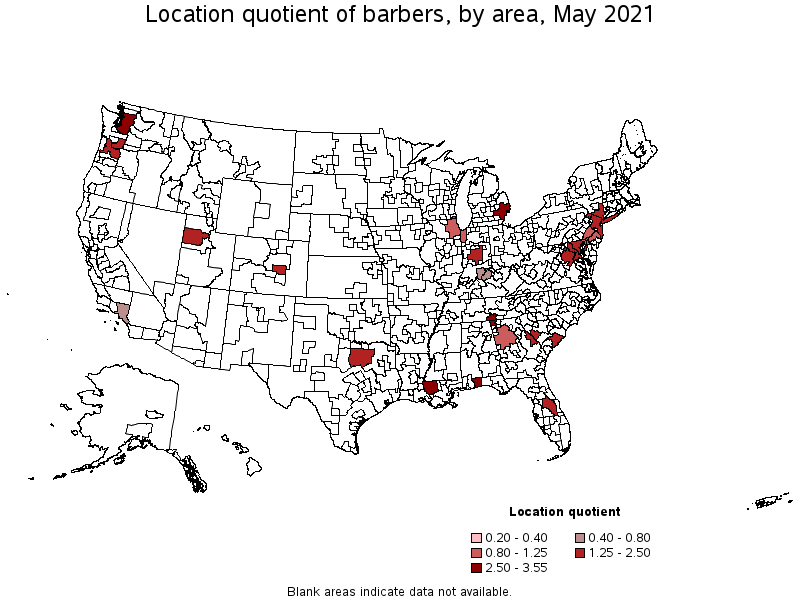
Metropolitan areas with the highest concentration of jobs and location quotients in Barbers:
| Metropolitan area | Employment (1) | Employment per thousand jobs | Location quotient (9) | Hourly mean wage | Annual mean wage (2) |
|---|---|---|---|---|---|
| Baton Rouge, LA | 120 | 0.33 | 3.55 | $ 18.04 | $ 37,510 |
| Pensacola-Ferry Pass-Brent, FL | 50 | 0.29 | 3.13 | $ 14.17 | $ 29,470 |
| Detroit-Warren-Dearborn, MI | 480 | 0.27 | 2.91 | $ 23.13 | $ 48,120 |
| Seattle-Tacoma-Bellevue, WA | 470 | 0.25 | 2.68 | $ 25.97 | $ 54,020 |
| Chattanooga, TN-GA | 60 | 0.23 | 2.53 | $ 13.63 | $ 28,340 |
| Orlando-Kissimmee-Sanford, FL | 240 | 0.20 | 2.24 | $ 16.52 | $ 34,350 |
| Salt Lake City, UT | 150 | 0.20 | 2.22 | $ 11.79 | $ 24,510 |
| New York-Newark-Jersey City, NY-NJ-PA | 1,740 | 0.20 | 2.19 | $ 18.01 | $ 37,460 |
| Indianapolis-Carmel-Anderson, IN | 200 | 0.20 | 2.18 | $ 15.26 | $ 31,730 |
| Colorado Springs, CO | 40 | 0.15 | 1.65 | $ 14.70 | $ 30,580 |
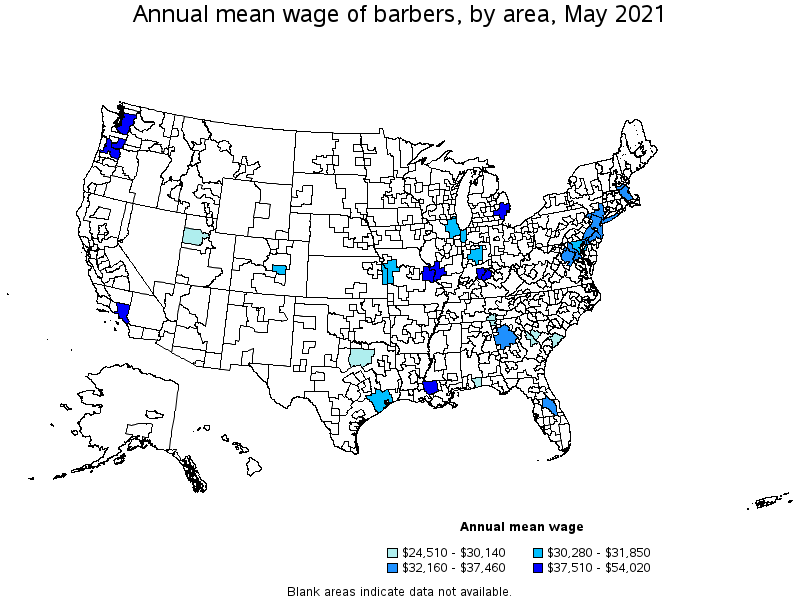
Top paying metropolitan areas for Barbers:
| Metropolitan area | Employment (1) | Employment per thousand jobs | Location quotient (9) | Hourly mean wage | Annual mean wage (2) |
|---|---|---|---|---|---|
| Seattle-Tacoma-Bellevue, WA | 470 | 0.25 | 2.68 | $ 25.97 | $ 54,020 |
| Portland-Vancouver-Hillsboro, OR-WA | 140 | 0.12 | 1.36 | $ 23.16 | $ 48,170 |
| Detroit-Warren-Dearborn, MI | 480 | 0.27 | 2.91 | $ 23.13 | $ 48,120 |
| Los Angeles-Long Beach-Anaheim, CA | 380 | 0.07 | 0.73 | $ 20.96 | $ 43,590 |
| Louisville/Jefferson County, KY-IN | 40 | 0.06 | 0.70 | $ 19.60 | $ 40,760 |
| St. Louis, MO-IL | (8) | (8) | (8) | $ 18.76 | $ 39,020 |
| Baton Rouge, LA | 120 | 0.33 | 3.55 | $ 18.04 | $ 37,510 |
| New York-Newark-Jersey City, NY-NJ-PA | 1,740 | 0.20 | 2.19 | $ 18.01 | $ 37,460 |
| Atlanta-Sandy Springs-Roswell, GA | 290 | 0.11 | 1.22 | $ 16.95 | $ 35,260 |
| Orlando-Kissimmee-Sanford, FL | 240 | 0.20 | 2.24 | $ 16.52 | $ 34,350 |
These estimates are calculated with data collected from employers in all industry sectors, all metropolitan and nonmetropolitan areas, and all states and the District of Columbia. The top employment and wage figures are provided above. The complete list is available in the downloadable XLS files.
The percentile wage estimate is the value of a wage below which a certain percent of workers fall. The median wage is the 50th percentile wage estimate—50 percent of workers earn less than the median and 50 percent of workers earn more than the median. More about percentile wages.
(1) Estimates for detailed occupations do not sum to the totals because the totals include occupations not shown separately. Estimates do not include self-employed workers.
(2) Annual wages have been calculated by multiplying the hourly mean wage by a "year-round, full-time" hours figure of 2,080 hours; for those occupations where there is not an hourly wage published, the annual wage has been directly calculated from the reported survey data.
(3) The relative standard error (RSE) is a measure of the reliability of a survey statistic. The smaller the relative standard error, the more precise the estimate.
(7) The value is less than .005 percent of industry employment.
(8) Estimate not released.
(9) The location quotient is the ratio of the area concentration of occupational employment to the national average concentration. A location quotient greater than one indicates the occupation has a higher share of employment than average, and a location quotient less than one indicates the occupation is less prevalent in the area than average.
Other OEWS estimates and related information:
May 2021 National Occupational Employment and Wage Estimates
May 2021 State Occupational Employment and Wage Estimates
May 2021 Metropolitan and Nonmetropolitan Area Occupational Employment and Wage Estimates
May 2021 National Industry-Specific Occupational Employment and Wage Estimates
Last Modified Date: March 31, 2022